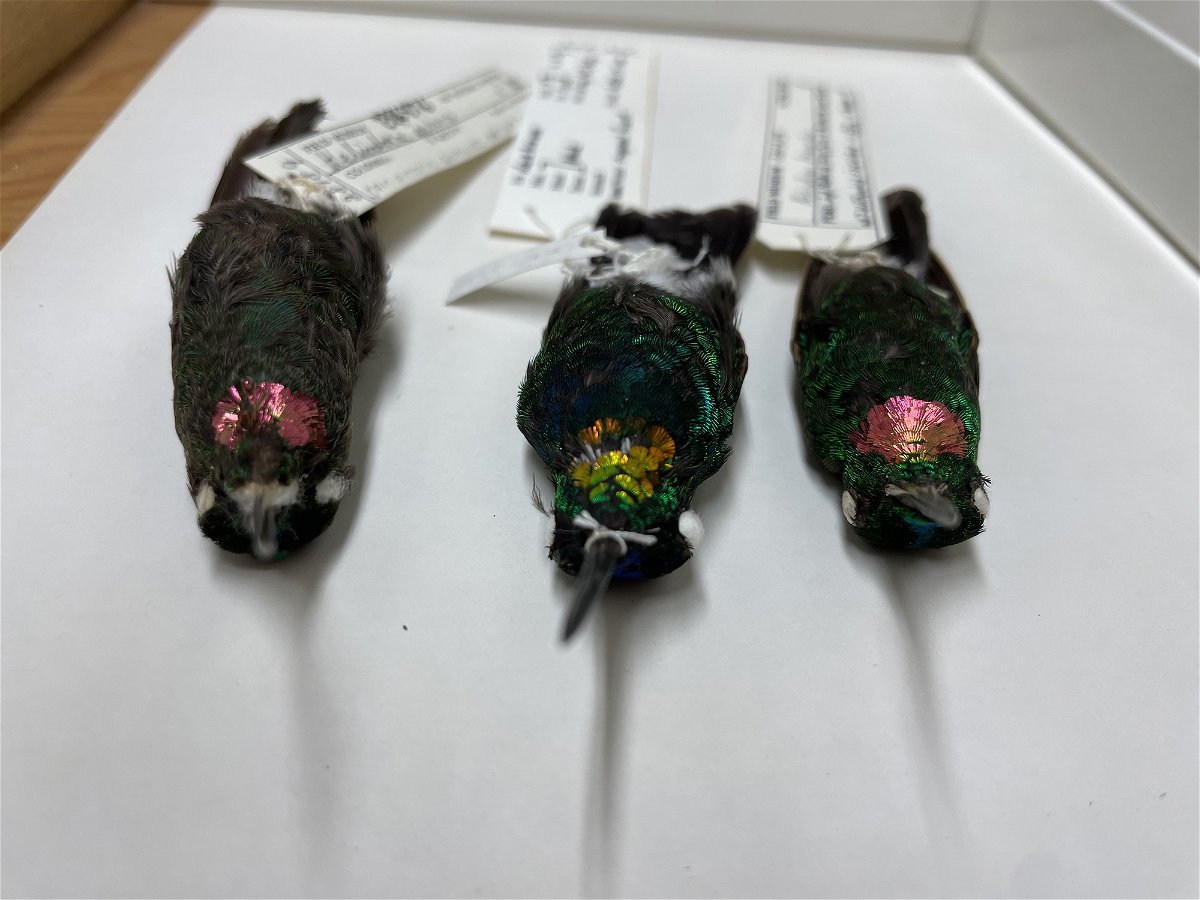Newly discovered hummingbird looks like it’s wearing a golden collar

The hybrid bird's gold feathers come from genetic material supplied by its two parent species H. gularis (left) and H. branickii (right).
By Ashley Strickland, CNN
When researchers found a hummingbird with shiny gold feathers on its throat in Peru’s Cordillera Azul National Park, they thought it was a newly discovered species.
The park, part of an outer ridge of the Andes Mountains’ eastern slopes, is an isolated place — the perfect spot to find a genetically distinct species.
“I looked at the bird and said to myself, ‘This thing doesn’t look like anything else.’ My first thought was, it was a new species,” said John Bates, a curator of birds at Chicago’s Field Museum, in a statement.
After concluding their fieldwork in Peru and returning to the Field Museum to conduct a DNA analysis of the bird, researchers made a surprising discovery.
The bird had never been documented before, but it was a hybrid that resulted from two related hummingbird species: the pink-throated Brilliant hummingbird, Heliodoxa gularis, and the Rufous-webbed Brilliant hummingbird, Heliodoxa branickii.
Both hummingbird species are known for having distinctly pink feathers on their throats, which led the researchers to question how pink mixed with pink could result in gold feathers.
“We thought it would be genetically distinct, but it matched Heliodoxa branickii in some markers, one of the pink-throated hummingbirds from that general area of Peru,” Bates said.
The initial DNA analysis focused on mitochondrial DNA, which is passed down from the mother’s side, and it matched Heliodoxa branickii.
The researchers then looked at the nuclear DNA, a result of genetic contributions from both parents of the bird, revealing aspects of Heliodoxa branickii and Heliodoxa gularis.
However, the gold-throated hummingbird wasn’t the result of an even genetic split. One of its ancestors was likely an even mix of the two species, while later generations appeared to have paired up with branickii hummingbirds.
A study detailing the findings published Wednesday in the journal Royal Society Open Science.
Since it’s rare for hummingbirds of the same species to have such wildly different throat feathers, the researchers dived deeper into the mystery of the gold feathers on the hybrid species.
“It’s a little like cooking: (I)f you mix salt and water, you kind of know what you’re gonna get, but mixing two complex recipes together might give more unpredictable results,” said study coauthor Chad Eliason, Field Museum senior research scientist, in a statement. “This hybrid is a mix of two complex recipes for a feather from its two parent species.”
The base color of feathers comes from pigment, like melanin, but feather cell structure and the way light reflects off the feathers create structural color. It’s this structural color that results in the iridescent nature of hummingbird feathers.
The research team studied the bird’s throat feathers using an electron microscope to measure how light bouncing off the feathers created different colors.
“There’s more than one way to make magenta with iridescence,” Eliason said. “The parent species each have their own way of making magenta, which is, I think, why you can have this nonlinear or surprising outcome when you mix together those two recipes for producing a feather color.”
The discovery suggests that hybrids may contribute to the rainbow of colors that appear in different hummingbirds.
“Based on the speed of color evolution seen in hummingbirds, we calculated it would take 6 (million to) 10 million years for this drastic pink-gold color shift to evolve in a single species,” Eliason said.
The researchers hope their work inspires others to keep an eye out for potential hybrid species of hummingbirds, Bates said.
“New tools like genetic data open up new understanding of how these events happen across geography and time,” Bates said. “One question we want to look into in the region in Peru where this study was done is how this complex foothill landscape has evolved through time and what role those changes have played in diversification of birds and other organisms.”
The-CNN-Wire
™ & © 2023 Cable News Network, Inc., a Warner Bros. Discovery Company. All rights reserved.